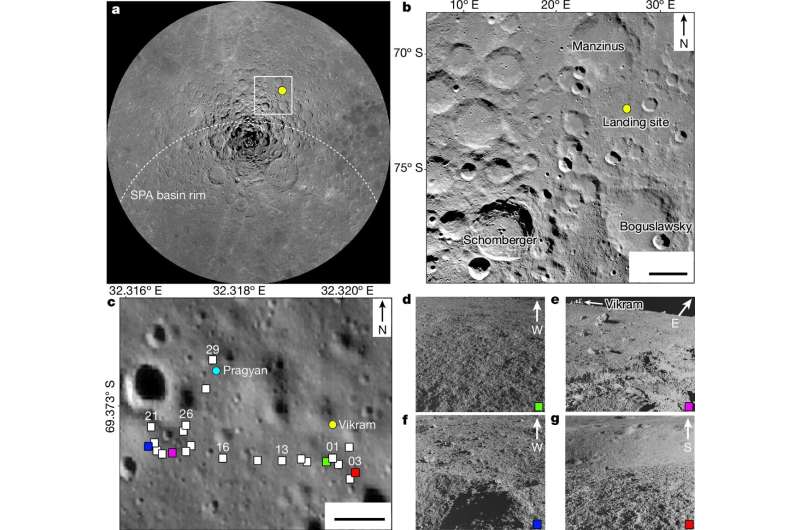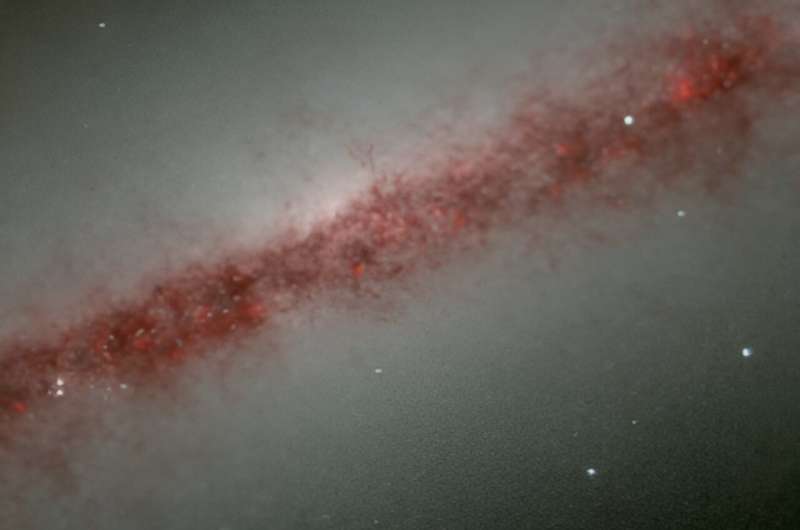SPACE
Beetle that pushes dung with the help of 100 billion stars unlocks the key to better navigation systems in drones and satellites
AI sensor accurately measures orientation of the Milky Way
image:
Dung beetles use the Milky Way at night to navigate. Engineers have used the same technique to develop an AI sensor for navigation in low light.
view moreCredit: University of South Australia
An insect species that evolved 130 million years ago is the inspiration for a new research study to improve navigation systems in drones, robots, and orbiting satellites.
The dung beetle is the first known species to use the Milky Way at night to navigate, focusing on the constellation of stars as a reference point to roll balls of dung in a straight line away from their competitors.
Swedish researchers made this discovery in 2013 and a decade later, Australian engineers are modelling the same technique used by the dung beetle to develop an AI sensor that can accurately measure the orientation of the Milky Way in low light.
University of South Australia remote sensing engineer Professor Javaan Chahl and his team of PhD students have used computer vision to demonstrate that the large stripe of light that forms the Milky Way is not affected by motion blur, unlike individual stars.
“Nocturnal dung beetles move their head and body extensively when rolling balls of manure across a field, needing a fixed orientation point in the night sky to help them steer in a straight line,” Prof Chahl says. “Their tiny compound eyes make it difficult to distinguish individual stars, particularly while in motion, whereas the Milky Way is highly visible.”
In a series of experiments using a camera mounted to the roof of a vehicle, the UniSA researchers captured images of the Milky Way while the vehicle was both stationery and moving. Using information from those images they have developed a computer vision system that reliably measures the orientation of the Milky Way, which is the first step towards building a navigation system.
Their findings have been published in the journal Biomimetics.
Lead author UniSA PhD candidate Yiting Tao says the orientation sensor could be a backup method to stabilise satellites and help drones and robots to navigate in low light, even when there is a lot of blur caused by movement and vibration.
“For the next step I want to put the algorithm on a drone and allow it to control the aircraft in flight during the night,” Tao says.
The sun helps many insects to navigate during the day, including wasps, dragonflies, honeybees, and desert ants. At night, the moon also provides a reference point for nocturnal insects, but it is not always visible, hence why dung beetles and some moths use the Milky Way for orientation.
Prof Chahl says insect vision has long inspired engineers where navigation systems are concerned.
“Insects have been solving navigational problems for millions of years, including those that even the most advanced machines struggle with. And they’ve done it in a tiny little package. Their brains consist of tens of thousands of neurons compared to billions of neurons in humans, yet they still manage to find solutions from the natural world.”
A video explaining the research is available here: Dung beetles guided by the Milky Way (youtube.com)
Notes for editors
“Computer vision techniques demonstrate robust orientation measurement of the Milky Way despite image motion” is published in Biomimetics. DOI: 10.3390/biomimetics9070375. It is authored by researchers at the University of South Australia and University of Lund.
How dung beetles are helping e [VIDEO] |
UniSA Professor Javaan Chahl explains how dung beetles and the Milky Way are helping engineers to improve navigation systems in drones, robots and satellites.
Credit
University of South Australia
Journal
Biomimetics
Method of Research
Computational simulation/modeling
Subject of Research
Not applicable
Article Title
Computer vision techniques demonstrate robust orientation measurement of the Milky Way despite image motion
First analysis of soil near the moon's south pole suggests its surface was once covered in molten magma

India's Chandrayaan-3 mission was launched last summer and its Vikram lander touched down on the moon's surface last August. Shortly thereafter, it released a rover called Pragyan. Since that time, the rover has been meandering around the surface of the moon near its south pole, collecting and testing soil samples along with measuring seismic activity and atmospheric conditions.
A team of geologists and planetary scientists at India's Physical Research Laboratory, working with colleagues from the U R Rao Satellite Center and the Space Applications Center, both in India, analyzed soil sample data collected by Pragyan, finding evidence bolstering theories that the moon's surface was completely molten not long after it was formed.
In their paper, published in the journal Nature, the group describes their analysis of radiation data sent back from the rover's alpha-particle X-ray spectrometer.
As part of soil testing, the rover used its alpha-particle X-ray spectrometer 23 times to learn more about the makeup of the moon's regolith. Thus far, data sent back from the sensor has shown that all 23 samples were made mostly of ferroan anorthosite.
Sensor data from other projects has shown that regolith in other areas, such as the moon's equator and mid-latitude zones, is made up of roughly the same material. This, the researchers note, suggests a uniform layer of material covering the moon.
Such a uniform layer bolsters theories that the moon's entire surface was covered by molten magma early in its history, the result of its manner of formation. The same theory also suggests the moon was formed when a large object named Theia slammed into the Earth, launching vast amounts of surface material into space.
The material coalesced into the moon, according to the theory. It also explains why so many moon rocks have a similar composition to those found on Earth. Such a collision would have generated a lot of heat, which would explain a molten-magma layer covering the moon's surface.
More information: Santosh Vadawale, Chandrayaan-3 APXS elemental abundance measurements at lunar high latitude, Nature (2024). DOI: 10.1038/s41586-024-07870-7. www.nature.com/articles/s41586-024-07870-7
Journal information: Nature © 2024 Science X NetworkPenetrating radar aboard the Chang'E-4 rover reveals layers of the moon's history
Astronomers explore the nature of galaxy NGC 891 with JWST

Using the James Webb Space Telescope (JWST), an international team of astronomers has observed a nearby spiral galaxy known as NGC 891. Results of the observational campaign, published August 15 on the preprint server arXiv, provide more insights into the nature of this galaxy and its circumgalactic medium.
Discovered in 1784, NGC 891 (also known as Caldwell 23 or the Silver Sliver Galaxy) is an edge-on, unbarred spiral galaxy located some 30 million light years away. It has a size of about 100,000 light years and is classified as a normal star-forming spiral galaxy with similarities to the Milky Way but with a slightly higher global star-formation rate (SFR).
Aiming to shed more light on the properties of NGC 891, a group of astronomers led by Jérémy Chastenet of the Ghent University in Belgium, decided to investigate this galaxy's circumgalactic medium (CGM) using JWST's Mid-Infrared Instrument (MIRI) and the Near-Infrared Camera (NIRCam).
"In this paper, we focus on the distribution of dust and stars in the disk-halo interface of the prototypical edge-on galaxy NGC 891 probed by the MIRI and NIRCam instruments on-board JWST. The unprecedented resolution and sensitivity of JWST let us resolve and study substructures in the CGM, which was never possible at these wavelengths," the researchers wrote in the study.
JWST allowed Chastenet's team to detect dust emission out to about 13,000 light years from the disk of NGC 891. This emission was identified in the form of filaments, arcs and super-bubbles.
It turned out that some of these filaments connect back to the mid-plane, to regions of high star formation rate in NGC 891. This finding suggests that feedback-driven galactic winds play an important role in regulating baryonic cycling.
Furthermore, the observations detected in NGC 891 the presence of dust in the form of small grains, and also likely polycyclic aromatic hydrocarbons (PAHs). Trying to explain the survival of dusty material for several tens of million years after having been ejected by galactic winds in the disk-halo interface, the astronomers offer the two most plausible scenarios.
"These small grains could be present in pockets of dense material and protected from ionizing radiation; this scenario agrees with simulations and a good match between emission and extinction in the literature," the researchers explained.
They added that the emission can also come from the surface layers of clouds, where the differential wind speed between hot and warm gas is enough to create a mixing layer, replenished by cooling material from the hot gas phase.
Further spectroscopic observations of the CGM in NGC 891 should be conducted in order to confirm which of the hypotheses is true.
More information: Jérémy Chastenet et al, JWST MIRI and NIRCam observations of NGC 891 and its circumgalactic medium, arXiv (2024). DOI: 10.48550/arxiv.2408.08026
Journal information: arXiv
© 2024 Science X NetworkAstronomers identify more than one thousand new star cluster candidates
Near-term NASA Mars and lunar in situ propellant production: complexity versus simplicity
Peer-Reviewed Publicationimage:
Fig. 1. Flowchart for carbothermal process [10].
view moreCredit: Space: Science & Technology
First, lunar ISPP is analyzed from aspects of lunar resources, near-term lunar processes, carbothermal process, polar ice, and reduction of iron oxides. There are basically 4 potential lunar resources: (1) Silicates in regolith containing typically >40% oxygen. (2) Regolith containing FeO for hydrogen reduction. FeO content may vary from 5% to 14%, leading to recoverable oxygen content in the 1 to 3% range. (3) Imbedded atoms in regolith from solar wind (typically parts per million). (4) Water ice in regolith pores in permanently shadowed craters near the poles (unknown percentage but possibly a few percent in some locations). NASA near-term plans for lunar ISPP appear to be based on H2 and O2 propellants. The carbothermal process (see Fig. 1) produces oxygen from lunar regolith. The plan is to have 2 ISPP modules, each operating independently in batch mode during a 7.4-month continuous sunlit period. The original plan called for each module to produce 8 tons of O2 per year, but a scaled-down version to produce 3.5 tons per year was provided instead. As for polar ice, the author imagines a system in which the excavator/hauler make 1200 trips, delivering 416 kg of water-laden regolith per trip, while the regolith processing station tankers make 37 trips, delivering 275 kg of water per trip. However, it should be noted that nobody has a reliable estimate based on in situ observation. The hydrogen reduction system operates by reducing metal oxides, mainly iron oxide, within the lunar regolith. However, Initial modeling exercises for predicting the overall system mass and power requirements for various oxygen production mass rates using hydrogen reduction which are developed by NASA yield impressively large figures.
Fig. 1. Flowchart for carbothermal process.
Then, Mars ISPP is analyzed from aspects of Mars resources, electrolysis of atmospheric CO2, reverse water gas synthesis (RWGS), and water-based Mars ISPP. Mars resources for ISPP include (a) the atmosphere containing ~95% CO2 as an oxygen supply, (b) regolith containing minerals with water of hydration as a source of H2O, and (c) water ice embedded in near-surface regolith at higher latitudes. The simplest and most straightforward approach to ISPP is electrolyzing CO2 in the Mars atmosphere, splitting CO2 into CO and O2. The system is shown in Fig. 5. It seems likely that NASA could leverage the field of solid oxide electrolysis cell (SOEC) technology with a relatively small investment, by continuing to adapt advances in terrestrial SOEC technology to space applications. As for RWGS, the efficiency is highly influenced by reaction temperature. It remains to be seen how efficient and practical this system will be when further developed. At last, argue that a water-based Mars ISPP is preferred rather than a process produces both CH4 and O2, because for the near term with a minimum of complexity, bringing CH4 to Mars is simpler than carrying water.
Fig. 5. The end-to-end CO2 electrolysis system.
Finally, power for lunar and Martian ISPPs are discussed. Every form of ISPP is power hungry. Providing power for ISPP on the Moon or Mars is a major challenge. The power requirement for ISPP on Mars is roughly comparable to the power requirement for life support after the crew arrives. Thus, the mass, cost, and logistics of the power system is not attributable to ISPP. By contrast, the power requirements for lunar ISPP far exceed the power requirements for life support, and furthermore, the power dissipated in lunar ISPP is additive to power for life support, so the entire mass, cost, and logistics for lunar ISPP power is attributable to lunar ISPP, reducing the ROI. For Mars ISPP, recent studies concluded that use of solar power might be more feasible than previously thought. Compared to nuclear power, solar power might offer mass advantages. Nevertheless, a plan for use of multiple kilopower reactors appears less risky to us. In addition, recent research on Li-CO2 batteries shows promise, and CO2 is readily available on Mars. But this does not appear to be near term. Power on the Moon can be derived from nuclear reactors or solar. Current thinking for lunar ISPP seems to be that solar concentrators would be constructed on a crater ridge and beamed down to a receiver within the permanently shadowed regions of the crater where the concentrated solar flux would be partly converted to electric power. A simpler approach might be a kilopower fission reactor and a tether with a copper wire to the water processing unit. An alternative approach is to beam power down from a satellite array. All in all, the author comes to the conclusion that despite the ongoing mission to return to the Moon, NASA might be best off bringing propellants to the Moon from Earth, while pursuing far more feasible Mars ISPP at a moderate level.
Journal
Space: Science & Technology
Article Title
Near-Term NASA Mars and Lunar In Situ Propellant Production: Complexity versus Simplicity
Article Publication Date
2-Aug-2024
 Download attachment
Download attachment
















